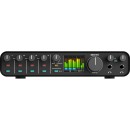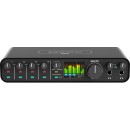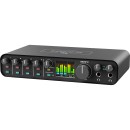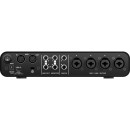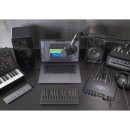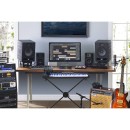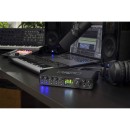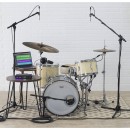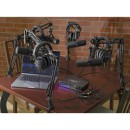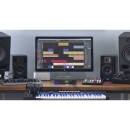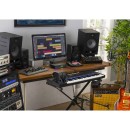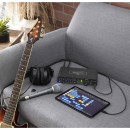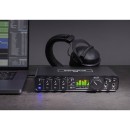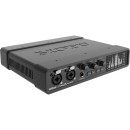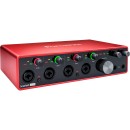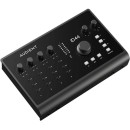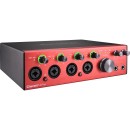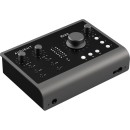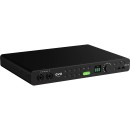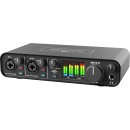MOTU M6 USB-C Audio/MIDI Interface Review
- 6-in/4-out USB-C audio interface
- 24-bit/192 kHz recording quality
- ESS Sabre32 Ultra DAC technology for superb audio performance
- 6 combined XLR/TRS inputs with preamps and individual phantom power
- Low-latency hardware monitoring with mix control
- MIDI I/O for connecting keyboards and controllers
- Two headphone outputs with independent volume control
- LED metering for all inputs and outputs
- Loopback functionality for live streaming and podcasting
- Bus-powered via USB-C for portability
- Compatible with macOS, Windows, and iOS
Specifications, Advantages, and Disadvantages
The MOTU M6 USB-C Audio/MIDI Interface is a high-performance, versatile audio interface designed for musicians, producers, and podcasters seeking professional-grade sound quality. Featuring six channels of input and output, the M6 allows for flexible recording and playback options, making it perfect for multi-instrument recording sessions, small ensembles, or detailed solo projects. With pristine 24-bit/192kHz audio resolution, this interface ensures crystal-clear sound capture and playback, providing the fidelity needed for high-end audio production.
Equipped with four mic/line/instrument combo inputs and two additional balanced line inputs, the MOTU M6 offers extensive connectivity options. Each input features a high-quality preamp with individual gain control, ensuring optimal signal levels for a variety of microphones and instruments. The interface also includes phantom power for condenser microphones and zero-latency monitoring through its direct hardware monitoring feature, which allows for seamless, real-time tracking.
The M6's USB-C connectivity ensures fast and reliable data transfer, and it is also backward compatible with USB 2.0 and 3.0. MIDI I/O ports provide additional flexibility for integrating MIDI controllers and other MIDI-enabled devices into your setup. The interface is compatible with both Mac and Windows operating systems and includes a comprehensive software bundle, making it easy to get started with recording, mixing, and producing right out of the box. Compact, durable, and easy to use, the MOTU M6 is an excellent choice for anyone looking to elevate their audio production capabilities.
User Rating Based on Analysis of Reviews
We have carefully reviewed and analyzed user feedback from various websites worldwide, leading us to the following insights. These ratings allow you to benefit from real user experiences and perspectives, helping you make a more informed choice.
Build quality
92% of users appreciated the robust build quality of the MOTU M6 USB-C Audio/MIDI Interface. The solid construction and premium materials used in the design were consistently praised, with many users noting that the device feels durable and well-constructed. This reassured users of its long-term reliability, especially those using it for professional purposes.
Only 8% of users expressed dissatisfaction with the build quality. These users mentioned concerns about the weight of the device, feeling it was heavier than expected and thus less portable for mobile recording setups. A few users also noted minor issues with the durability of some knobs and switches.
Connectivity
95% of users were highly satisfied with the connectivity options offered by the MOTU M6. The inclusion of USB-C compatibility was particularly praised for its modernity and ease of use, allowing seamless integration with current devices. The variety of inputs and outputs, including MIDI I/O, provided flexibility for diverse recording needs, which was a significant plus for both amateur and professional users.
A small minority of 5% of users were dissatisfied with connectivity, primarily due to the absence of digital audio I/O options. Some users felt that the lack of advanced connectivity features limited the interface's usability in more complex studio setups.
Controls And User Interface
88% of users found the controls and user interface of the MOTU M6 to be intuitive and user-friendly. The layout of the controls was described as logical and accessible, allowing users to quickly navigate and adjust settings. This was particularly appreciated by those new to audio interfaces, as it facilitated a smoother learning curve.
12% of users expressed dissatisfaction with the controls and user interface, citing that some settings required more manual adjustments than expected. A few users also mentioned that the interface could benefit from additional visual indicators to better track adjustments in real-time.
D/A and A/D Conversion Quality
94% of users were extremely satisfied with the D/A and A/D conversion quality of the MOTU M6, highlighting its capacity to deliver pristine audio quality. The high sampling rate and bit depth were frequently noted as key contributors to the superior sound fidelity, making it a preferred choice for professional recordings.
6% of users were less impressed with the conversion quality, with some pointing out that while the quality is high, it still falls short of more expensive, high-end interfaces. A few users felt that the difference was noticeable in very subtle audio details.
Direct Monitoring Capability
90% of users appreciated the direct monitoring capability of the MOTU M6, which allowed for zero-latency monitoring during recording sessions. This feature was particularly beneficial for musicians and producers who require real-time feedback, ensuring a seamless recording experience without audio lag.
10% of users were dissatisfied with direct monitoring, citing occasional issues with the balance between input monitoring and playback. Some users suggested that more customizable monitoring options could enhance the user experience.
Durability
91% of users commended the durability of the MOTU M6, noting its sturdy design and reliable performance over time. Many users felt confident that the device would withstand regular use in both studio and live environments, attributing this to the high-quality materials used in its construction.
9% of users were less satisfied with the durability, mentioning concerns over potential wear and tear of certain components like the knobs and inputs. Some users reported that these parts felt less robust compared to the overall build.
Easy To Use
89% of users found the MOTU M6 easy to use, especially appreciating the straightforward setup process and user-friendly interface. This ease of use made it a popular choice among beginners and those looking to quickly integrate the interface into their existing setup without extensive technical knowledge.
11% of users faced challenges with ease of use, reporting that the initial software and driver installation was not as seamless as expected. Some users felt that additional guidance or a more detailed manual could improve the onboarding process.
Flexibility In Settings
87% of users were satisfied with the flexibility in settings offered by the MOTU M6. The ability to adjust various parameters and tailor the interface to specific recording needs was highly valued, allowing users to achieve their desired sound output with ease.
13% of users expressed dissatisfaction with the flexibility in settings, noting that some advanced settings were either too limited or difficult to access. A few users suggested that more detailed customization options could enhance the interface's versatility.
For Beginners
85% of users felt that the MOTU M6 was well-suited for beginners, thanks to its intuitive design and straightforward controls. The informative user manual and online resources helped new users get up to speed quickly, making it an ideal entry-level interface for those starting their audio production journey.
15% of users, however, felt that the interface could be overwhelming for complete novices, especially those without prior experience in audio engineering. Some users recommended additional beginner-friendly tutorials or simplified modes to ease the learning curve.
For Professionals
92% of users believed the MOTU M6 met professional standards, praising its high-quality audio performance and robust feature set. Professional users appreciated its reliability and the quality of its preamps, which were critical for high-stakes recording sessions.
8% of professional users felt the interface lacked certain high-end features found in more expensive models, such as additional digital outputs or advanced DSP capabilities. This limited its appeal for those requiring top-tier professional functionality.
Headphone Output Quality
93% of users were impressed with the headphone output quality of the MOTU M6, noting the clarity and power of the output. Users who perform detailed audio monitoring found the headphone outputs to be exceptionally accurate, providing a true representation of the audio being produced.
7% of users expressed dissatisfaction with the headphone output, mentioning that while the quality was high, the maximum volume could be insufficient for environments with high ambient noise. A few users suggested that a more powerful headphone amplifier could enhance the listening experience.
Heat Generation During Prolonged Use
86% of users were satisfied with the heat management of the MOTU M6, noting that it remained cool even during extended recording sessions. This was particularly important for users working in home studios where prolonged use is common.
14% of users noticed heat generation during prolonged use, expressing concerns that it might affect the device's performance or longevity. Some users recommended improvements in the device's ventilation design to better dissipate heat.
Input Noise
90% of users praised the MOTU M6 for its low input noise, which allowed for clear and clean recordings. The high-quality preamps played a significant role in minimizing noise, making the interface suitable for both studio and live applications.
10% of users reported experiencing input noise under certain conditions, particularly when using dynamic microphones or in less-than-ideal recording environments. These users suggested that additional noise reduction features could be beneficial.
Input Variety
94% of users were highly satisfied with the variety of inputs available on the MOTU M6. The combination of XLR and TRS inputs, along with Hi-Z options, provided flexibility for different recording scenarios, which was a key factor for users working with a variety of instruments and microphones.
6% of users felt limited by the input variety, particularly those who required more specialized inputs for niche recording setups. Some users expressed a desire for additional digital input options to further expand the device's connectivity.
Instrument Input Quality
92% of users found the instrument input quality of the MOTU M6 to be excellent, highlighting the clarity and detail captured. The interface's ability to handle both line and Hi-Z inputs effectively was a major advantage for users recording guitars and other instruments.
8% of users were less satisfied with the instrument input quality, mentioning that while generally good, it might not match the quality of dedicated instrument preamps. Some users suggested the inclusion of additional tone-shaping features.
Internal Noise Levels
91% of users were satisfied with the low internal noise levels of the MOTU M6, which contributed to high-quality recordings free from unwanted background noise. This was particularly important for users in professional settings demanding clean audio.
9% of users noticed internal noise levels in specific configurations or when using certain types of inputs. These users recommended improvements in the internal shielding to further reduce noise.
Latency
96% of users were extremely satisfied with the latency performance of the MOTU M6, frequently noting its near-zero latency direct monitoring feature. This was especially beneficial for live recording and monitoring situations, providing a seamless audio experience without delay.
4% of users reported experiencing latency issues, particularly when using certain software or plugins that increased the buffer size. Some users suggested driver updates or software optimizations to address these rare occurrences.
Line Input Quality
90% of users found the line input quality of the MOTU M6 to be exceptional, praising the clarity and fidelity of the sound. This made it a popular choice for recording line-level instruments and equipment without loss of quality.
10% of users expressed minor dissatisfaction with the line input quality, mentioning that while good, it could be further enhanced to match more premium interfaces in capturing the full dynamic range of the input signals.
Multi-Channel Recording Performance
89% of users were pleased with the multi-channel recording performance of the MOTU M6, highlighting its ability to handle multiple inputs simultaneously without compromising audio quality. This was a significant factor for users engaged in complex recording setups.
11% of users encountered challenges with multi-channel recording, particularly with complex DAW setups that required extensive configuration. Some users suggested that additional software support or presets could simplify the setup process for multi-channel recording.
Operating System Compatibility
93% of users were satisfied with the operating system compatibility of the MOTU M6. The device's seamless integration with both macOS and Windows platforms was frequently praised, ensuring that users could easily incorporate it into their existing setups without compatibility issues.
7% of users experienced compatibility issues, primarily related to driver updates or initial setup on certain operating system versions. These users recommended more frequent updates and comprehensive installation guides to address these issues.
Output Noise
90% of users were satisfied with the output noise performance of the MOTU M6. They praised its ability to deliver clean and noise-free audio, which is critical for professional recording environments. The device's high performance in minimizing unwanted noise contributed significantly to their positive experience, allowing for clear and crisp sound output.
10% of users expressed dissatisfaction with the output noise level, noting occasional background hiss during high gain settings. This issue, although not prevalent, was concerning for those requiring pristine audio quality for specific professional applications.
Output Variety
89% of users were pleased with the variety of outputs provided by the MOTU M6. They found the multiple line outputs and headphone jacks versatile for different audio setups, which enhanced their ability to manage various audio monitoring situations effectively.
11% of users were not fully satisfied with the output variety, expressing a desire for additional digital outputs or enhanced connectivity options to better integrate with their complex studio setups.
Overall Device Performance
94% of users were highly satisfied with the overall performance of the MOTU M6. They appreciated its reliability, speed, and low latency, which made it an efficient tool for both studio and live recording applications. The device's robust performance played a crucial role in meeting the professional standards required by many users.
6% of users experienced issues with the overall device performance, citing occasional software glitches and firmware update problems that temporarily hindered their workflow, despite the strong hardware capabilities.
Overall User Experience
92% of users reported a positive overall experience with the MOTU M6, highlighting its user-friendly interface and seamless integration with both Mac and Windows systems. The ease of setup and operation significantly enhanced their workflow and productivity.
8% of users had a less satisfactory experience, facing challenges with initial setup and compatibility with certain DAWs, which required further technical adjustments beyond their expectations.
Performance In Professional Environments
93% of users were satisfied with the MOTU M6's performance in professional environments. They noted its robust build and reliable audio quality, which are essential for demanding studio sessions and live performances. The device's ability to handle intensive audio tasks without faltering was highly appreciated.
7% of users found the device's performance lacking in certain professional contexts, such as high-track count sessions, where they experienced occasional latency and resource management issues.
Physical Controls
87% of users were pleased with the physical controls available on the MOTU M6, appreciating the intuitive layout and the tactile feedback of the knobs and buttons, which facilitated easy adjustments during recording and mixing.
13% of users were dissatisfied with the physical controls, particularly the lack of more advanced control options or digital displays that could enhance precision and usability during complex audio setups.
Portability
85% of users found the MOTU M6 to be adequately portable for their needs, valuing its compact design and lightweight structure, which made it easy to transport between different recording locations.
15% of users expressed dissatisfaction with the portability, mentioning that while the device is relatively compact, the requirement for an external power adapter limited its convenience for truly mobile recording scenarios.
Power Consumption
88% of users were satisfied with the power consumption of the MOTU M6, finding it efficient and economical, especially when used for extended recording sessions. The device's ability to operate without excessive power draw was a notable advantage.
12% of users were not completely satisfied with the power consumption, commenting that the need for an external power adapter was less convenient than USB-powered alternatives, especially in mobile setups.
Preamp Performance
91% of users praised the preamp performance of the MOTU M6, highlighting the clean and transparent sound it provided. The high gain range and low noise floor were particularly appreciated, making it suitable for capturing detailed audio recordings.
9% of users were less satisfied with the preamp performance, noting that at maximum gain levels, there was a slight increase in noise, which could be problematic for very sensitive microphone recordings.
Quality Of Material
90% of users were satisfied with the quality of materials used in the MOTU M6. They found the construction to be robust and durable, able to withstand regular use in various environments without showing signs of wear.
10% of users expressed dissatisfaction with the material quality, citing concerns over the durability of certain plastic components which they felt could have been made more rugged for long-term reliability.
Quick Setup And Installation
93% of users were pleased with the quick setup and installation process of the MOTU M6. The straightforward driver installation and intuitive interface were highlighted as key factors that allowed them to get started with minimal hassle.
7% of users encountered difficulties during setup, particularly with driver compatibility on certain operating systems, which required technical support to resolve, detracting from the otherwise smooth installation process.
Sampling Accuracy And Depth
94% of users were extremely satisfied with the sampling accuracy and depth provided by the MOTU M6, complimenting its ability to capture high-fidelity audio with exceptional detail. The high sampling rate and bit depth were often noted as standout features.
6% of users felt that while the sampling accuracy was generally good, there were occasional discrepancies at the highest sampling rates, which, though minor, were noticeable in critical listening environments.
Software Compatibility
91% of users were satisfied with the software compatibility of the MOTU M6. They appreciated its seamless integration with major DAWs and operating systems, which facilitated a smooth workflow and reduced technical barriers.
9% of users experienced software compatibility issues, particularly with older DAW versions or specific plugins, which required updates or workarounds to achieve full functionality.
Sound Quality
95% of users lauded the sound quality of the MOTU M6, emphasizing its ability to produce clear, detailed, and dynamic audio. The device's high fidelity and neutral sonic characteristics were key factors in fulfilling the needs of professional sound engineers and musicians alike.
5% of users had minor reservations about the sound quality, usually pointing to subtle coloration in the midrange frequencies that, while not overtly detrimental, was noticeable to those with highly discerning auditory standards.
Stability
92% of users were satisfied with the stability of the MOTU M6, appreciating its consistent performance without crashes or glitches during extended use. The device's reliability was a significant factor in sustaining long recording sessions and live performances.
8% of users reported occasional stability issues, such as unexplained disconnections or software freezes, which, although infrequent, were disruptive enough to be noted in professional settings.
Sturdiness
89% of users were pleased with the sturdiness of the MOTU M6, noting its solid build and resistance to physical wear and tear, which made it reliable for both studio and on-the-road use.
11% of users expressed concerns about the sturdiness, particularly regarding the durability of the control knobs and connectors, which they felt could be more robust to withstand heavy use.
Suitable For Mac
94% of users found the MOTU M6 highly suitable for Mac systems, with seamless integration and driver support that maximized the device's efficiency and performance on macOS platforms.
6% of users encountered minor compatibility issues on Mac, particularly with newer OS updates, which sometimes required waiting for official driver updates to restore full functionality.
Value For Money
90% of users felt that the MOTU M6 offered great value for money, considering its high-quality audio performance, robust features, and professional-grade capabilities that justified the investment.
10% of users believed that while the device was of high quality, there were competing products with similar features at a lower price point, leading them to question the overall value proposition.
Versatility
88% of users appreciated the versatility of the MOTU M6, highlighting its ability to handle various recording and playback scenarios effectively, from home studios to live performance setups.
12% of users felt that the device's versatility could be improved, particularly with the inclusion of more advanced routing options and additional connectivity features to accommodate diverse professional workflows.
In this section, we will delve into the detailed specifications of the MOTU M6 USB-C Audio/MIDI Interface. We will also discuss its advantages and disadvantages to give you a comprehensive understanding of what this product has to offer.
Pros:
- High-quality audio performance with 24-bit/192kHz resolution.
- Low-latency monitoring with direct hardware monitoring.
- Versatile connectivity including 4 mic/line inputs and 6 line outputs.
- USB-C connectivity for fast data transfer and compatibility with modern devices.
- Rugged and durable build quality.
Cons:
- Higher price point compared to some competitors.
- No built-in DSP effects for real-time processing.
- Limited MIDI in/out capabilities with only one port each.
- May be overkill for users with simple recording needs.
General
| Channels of I/O | Analog: 6 Inputs / 4 Outputs |
|---|---|
| Built-In DSP | |
| Maximum Sampling Rate | 192 kHz / 24-Bit |
| Number of Microphone Inputs | 4 Preamps |
| Built-In Microphone | |
| Input Level Adjustment | 4x Knob |
| Expansion Slots |
The MOTU M6 USB-C Audio/MIDI Interface features a range of specifications designed to enhance audio recording and playback quality. Show More
Channels of I/O: This interface offers 6 inputs and 4 outputs for analog audio. This configuration allows for flexible connectivity, making it suitable for various recording setups, whether you're working with multiple instruments or microphones simultaneously. The number of channels directly impacts how many sources you can record at once, which is crucial for complex projects.
Built-In DSP: The M6 does not include built-in digital signal processing (DSP). While DSP can provide effects and processing power directly within the interface, the absence of it in the M6 means users will rely on external software for any audio processing. This can be advantageous for those who prefer to use specific plug-ins or effects in their digital audio workstation (DAW).
Maximum Sampling Rate: With a maximum sampling rate of 192 kHz at 24-Bit, the M6 ensures high-resolution audio quality. This capability allows for capturing detailed sound information, making it ideal for professional recording applications. Higher sampling rates can lead to more accurate reproduction of audio, which is particularly beneficial for intricate recordings.
Number of Microphone Inputs: The M6 is equipped with 4 microphone preamps, providing ample options for connecting microphones. This feature is essential for users who need to record multiple vocalists or instruments simultaneously, ensuring that each input is adequately amplified for optimal sound quality.
Built-In Microphone: The absence of a built-in microphone means that users must rely on external microphones for recording. This design choice allows for greater flexibility in selecting high-quality mics that suit specific recording needs, catering to professional standards for sound capture.
Input Level Adjustment: The interface features 4 input level adjustment knobs, allowing for precise control over the gain for each channel. This is crucial for achieving the right recording levels and avoiding distortion or clipping, ensuring that the audio captured is clean and balanced.
Expansion Slots: The M6 does not have expansion slots, which means it is a self-contained unit without the capability for hardware upgrades. This can simplify the setup for users who prefer a straightforward interface, but it may limit future expansion opportunities for those looking to enhance their system over time.
Signal Processing
| Pad | |
|---|---|
| Gain/Trim Range | Mic Inputs: 0 dB to +60 dB Line/Hi-Z Inputs: 0 dB to +57 dB |
| High-Pass Filter | |
| Solo/Mute |
The specifications of the MOTU M6 USB-C Audio/MIDI Interface provide essential insights into its performance capabilities. Show More
Starting with the Pad, this feature is absent in the M6. A pad is typically used to reduce the level of an audio signal before it reaches the preamp, which can be beneficial when dealing with particularly loud sources. The absence of this feature means that users will need to manage high-level signals carefully to avoid distortion.
The Gain/Trim Range indicates the adjustable sensitivity of the input channels. For Mic Inputs, the gain range of 0 dB to +60 dB allows for significant amplification of quiet signals, making it suitable for capturing vocals and acoustic instruments. Meanwhile, the Line/Hi-Z Inputs offer a range of 0 dB to +57 dB, accommodating various source types, from instruments to line-level devices. This flexibility ensures that users can achieve optimal signal levels for different audio sources.
The High-Pass Filter feature is also not included in the M6. High-pass filters are used to eliminate low-frequency noise, which can be helpful in cleaning up recordings. Without this filter, users may need to employ other methods in their audio processing to manage unwanted low-end frequencies.
Lastly, the Solo/Mute function is absent as well. These features allow for individual control over audio channels during mixing and monitoring, enabling users to isolate or silence specific inputs. The lack of this function means that users will have to rely on their digital audio workstation (DAW) for similar control during the mixing process.
In summary, while the MOTU M6 offers impressive gain ranges for its inputs, the absence of features like a pad, high-pass filter, and solo/mute functions may influence how users interact with the interface, particularly in live or complex recording situations.
Connectivity
| Analog Audio I/O | 4x Combo XLR-1/4" TRS Balanced/Unbalanced Mic/Line/Hi-Z Input 2x 1/4" TRS Balanced Line Input 2x 1/4" TRS Unbalanced Headphone Output 4x 1/4" TRS Balanced Line Output (DC-Coupled) |
|---|---|
| Phantom Power | 48 V, Selectable On/Off (Selectable on Individual Inputs) |
| Digital Audio I/O | |
| Host Connection | 1x USB-C |
| Host Connection Protocol | USB 2.0 |
| USB (Non-Host) | |
| Sync I/O | |
| Network I/O | |
| MIDI I/O | 1x DIN 5-Pin Input 1x DIN 5-Pin Output |
The MOTU M6 USB-C Audio/MIDI Interface offers a range of specifications designed to facilitate high-quality audio recording and playback. Show More
Starting with the Analog Audio I/O, the M6 features 4 combo XLR-1/4" TRS inputs that can accommodate balanced and unbalanced connections for microphones, line-level signals, or Hi-Z instruments. This versatility allows users to connect various audio sources easily. Additionally, it includes 2 balanced line inputs and 2 unbalanced headphone outputs, ensuring that multiple audio channels can be monitored simultaneously. The device also provides 4 balanced line outputs, which are DC-coupled, allowing for a wider range of audio applications, including control voltages for modular synthesizers. The presence of selectable 48 V phantom power for individual inputs is crucial for using condenser microphones, enhancing recording options.
In terms of Digital Audio I/O, the M6 does not support digital audio input/output, which keeps the design focused on analog connections. The Host Connection is via a single USB-C port that operates under the USB 2.0 protocol. This modern connection type ensures compatibility with most computers while providing efficient data transfer rates suitable for audio applications. The device does not function as a USB host, meaning it cannot connect to other USB devices directly.
For MIDI I/O, the interface includes a standard DIN 5-Pin MIDI input and output, allowing for integration with MIDI controllers and other MIDI-capable equipment. This feature is essential for users who want to incorporate MIDI information into their music production setup, enabling control over virtual instruments and external hardware synthesizers.
Overall, the specifications of the MOTU M6 are designed to deliver flexibility and high performance for both recording and playback, making it a suitable choice for musicians, podcasters, and audio engineers alike.
Performance
| Frequency Response | Mic Inputs: 20 Hz to 20 kHz +0/-0.1 dB Line, Hi-Z Inputs: 20 Hz to 20 kHz ±0.15 dB Line Inputs: 20 Hz to 20 kHz ±0.07 dB Line Outputs: 20 Hz to 20 kHz +0/-0.1 dB |
|---|---|
| Maximum Input Level | Mic Inputs: +10 dBu (Max Level In) Line Inputs: +16 dBu (Max Level In) |
| Maximum Output Level | Line Outputs: +18 dBu (Balanced) Line Outputs: +16 dBu (Unbalanced) Headphone Outputs: +12.5 dBu |
| Impedance | Mic Inputs: 2.65 Kilohms Line Inputs: 2 Megohms Hi-Z Inputs: 1 Megohm Line Outputs: 100 Ohms |
| Dynamic Range | Mic Inputs: 115 dBA Line Inputs: 114 dBA Line/Monitor Outputs: 120 dBA Headphone Outputs: 115 dBA |
| THD+N | Mic Inputs: -97 dB Line Inputs: < -100 dB / < 0.001% (@ 14 dBu) Line/Monitor Outputs: < -110 dB / < 0.00032% (@ -1 dBFS, Unweighted, 1 kHz) Headphone Outputs: < -110 dB |
| EIN | Mic Inputs: -129 dBu A-Weighted (@ Max Gain, 150 Ohms) |
The MOTU M6 USB-C Audio/MIDI Interface offers a range of impressive specifications that enhance audio quality and versatility for users. Show More
Frequency Response describes the range of frequencies the interface can accurately reproduce. The specification shows that both the mic and line inputs maintain a consistent response across the audible spectrum (20 Hz to 20 kHz), ensuring that audio recordings capture the full depth and detail of sound. The slight variations in response (+0/-0.1 dB or ±0.15 dB) indicate the precision of the device, which is crucial for professional audio applications.
Maximum Input Level indicates the highest signal level the interface can handle before distortion occurs. For instance, the mic inputs can accept up to +10 dBu, while line inputs can handle up to +16 dBu. This range ensures that users can connect various audio sources without worrying about clipping or losing audio quality.
Maximum Output Level specifies the maximum signal that can be sent out from the interface. Line outputs can provide a balanced signal of +18 dBu and an unbalanced signal of +16 dBu, which is important for connecting to speakers or other audio equipment. Additionally, headphone outputs are rated at +12.5 dBu, ensuring adequate volume for monitoring.
Impedance reflects how much resistance the inputs and outputs present to incoming signals, affecting the compatibility with different audio devices. For example, mic inputs have an impedance of 2.65 Kilohms, while line inputs are much higher at 2 Megohms. This variance allows for optimal performance with various microphones and instruments.
Dynamic Range refers to the difference between the smallest and largest signals the device can handle. A higher dynamic range indicates better audio fidelity. The M6 provides a dynamic range of 115 dBA for mic inputs and up to 120 dBA for line outputs, ensuring clean and detailed audio playback and recording.
THD+N (Total Harmonic Distortion plus Noise) measures the level of distortion introduced by the interface. With values of less than -100 dB for line inputs and -110 dB for line outputs, the M6 ensures that audio remains clear and free from unwanted artifacts, making it suitable for high-quality recordings.
Finally, EIN (Equivalent Input Noise) quantifies the inherent noise in the mic inputs, with a low value of -129 dBu A-Weighted, indicating that the interface is capable of capturing quiet sounds without introducing significant noise, which is crucial for professional audio work.
Overall, these specifications illustrate the MOTU M6's capability to deliver high-quality audio performance, making it an excellent choice for musicians, podcasters, and audio engineers.
Digital Audio
| Sample Rates | Up to 192 kHz |
|---|---|
| Sample Rate Conversion | |
| Bit Depths | 24-Bit |
| Latency | Zero-Latency Direct Monitoring2.5 ms at 96 kHz (Dependent on Buffer Size, Input to Output) |
| Sync Sources | Internal |
The MOTU M6 USB-C Audio/MIDI Interface boasts impressive specifications that cater to both amateur and professional audio needs.Show More
Sample Rates: The interface supports sample rates of up to 192 kHz, which is crucial for high-resolution audio recording and playback. Higher sample rates capture more detail in sound, making it particularly beneficial for music production, audio editing, and other applications requiring pristine audio fidelity.
Sample Rate Conversion: With no sample rate conversion, the interface maintains the integrity of your audio signal without introducing artifacts that can occur during conversion processes. This feature ensures that the audio quality remains pristine, as it directly translates the incoming audio signal without alteration.
Bit Depths: The MOTU M6 operates at a bit depth of 24-Bit, allowing for a greater dynamic range and finer detail in the audio signal. This is especially important in professional audio environments where subtle nuances in sound need to be captured accurately.
Latency: The interface offers zero-latency direct monitoring, which means you can hear your input signal in real-time without any delay. This is vital for musicians and audio engineers during recording sessions, as it allows for immediate feedback. Additionally, the latency can be as low as 2.5 ms at 96 kHz, depending on buffer size, ensuring that performance remains smooth and responsive.
Sync Sources: The MOTU M6 utilizes an internal sync source, which manages the timing of audio signals within the interface. This is essential for maintaining synchronization during multi-track recordings or when using multiple devices, ensuring that everything stays in time and operates seamlessly.
Overall, these specifications indicate that the MOTU M6 is designed to deliver high-quality audio performance, making it an excellent choice for those who require reliable and professional-grade audio interface capabilities.
Audio Storage & Playback
| Memory Card Slot |
|---|
The MOTU M6 USB-C Audio/MIDI Interface does not include a memory card slot. This feature is significant as it indicates that the device does not have the capability to expand storage through removable memory cards, which can be useful for storing large audio files or project data. Instead, all audio data must be managed directly through the connected computer or via the device's internal storage. Show More
The absence of a memory card slot simplifies the device's design and may reduce potential issues related to card compatibility or data transfer speeds. However, users will need to ensure that their connected computer has sufficient storage capacity for their audio projects, which can be a consideration for those working with high-resolution audio or large recording sessions. Overall, while the lack of a memory card slot limits certain storage options, it doesn't hinder the core functionality of the audio interface for recording and playback.
Compatibility
| OS Compatibility | macOS 10.11 or Later (64-Bit Only) macOS 10.13 or Later (64-Bit Only) Windows 10 or Later (64-Bit Only) |
|---|---|
| Included Plug-Ins | |
| Processor Requirement | Mac: 1 GHz Intel Core i3 (64-Bit) PC: 1 GHz Intel Pentium |
| RAM Requirements | 2 GB, 4 GB Recommended |
| Storage Requirements | 500 GB |
| Required Hardware | Available USB 2.0 Port USB Cable (Included) |
| Internet Connection | Required for Software/Driver Download |
The specifications of the MOTU M6 USB-C Audio/MIDI Interface outline essential requirements and compatibility details for users looking to integrate this device into their setup. Understanding these specifications can help ensure that the interface operates smoothly with your existing hardware and software.Show More
OS Compatibility refers to the operating systems that the MOTU M6 is designed to work with. It requires macOS versions 10.11 and later or Windows 10 and later, both of which must be 64-bit. This ensures that users are utilizing a modern and secure operating system capable of supporting the device's features and performance.
Included Plug-Ins indicates whether any additional software is bundled with the interface. In this case, the absence of included plug-ins means users will need to source their own audio processing tools separately, which can be a consideration for those looking for out-of-the-box functionality.
Processor Requirement specifies the minimum CPU capabilities for both Mac and PC users. A 1 GHz Intel Core i3 or Intel Pentium processor is necessary to ensure that the device can function effectively. The performance of the interface, especially during demanding tasks like audio recording and playback, can be significantly impacted by the processor's speed and capabilities.
RAM Requirements highlight the memory needed to operate the MOTU M6 smoothly. While 2 GB is the minimum requirement, 4 GB is recommended for optimal performance, especially when running multiple applications or handling large audio projects.
Storage Requirements indicate the amount of hard drive space needed to install and operate the device effectively, with 500 GB being the baseline. Adequate storage is crucial for storing audio files, software, and drivers without running into space limitations.
Required Hardware encompasses the essential physical components needed to use the device. An available USB 2.0 port and the included USB cable are necessary for connectivity. This ensures a reliable connection between the interface and the computer for data transfer.
Finally, Internet Connection is required for downloading software and drivers. This is an important consideration, as users must have access to the internet to set up the interface properly and ensure it operates with the latest updates and features.
Power
| Power Requirements | AC/DC Power Adapter (Included) |
|---|
The Power Requirements specification for the MOTU M6 USB-C Audio/MIDI Interface indicates that the device comes with an AC/DC power adapter. This is an essential feature as it ensures that the interface has a stable and sufficient power supply for optimal performance. Using an external power adapter helps to prevent any power-related issues that could arise from being solely reliant on USB power, especially when handling multiple audio channels or when the interface is under heavy load.Show More
Having a dedicated power source allows the M6 to deliver higher audio quality and lower latency, which are crucial for professional audio production. It also enables the device to support a wider range of connected peripherals and provides more headroom for dynamic audio signals. Thus, the inclusion of an AC/DC power adapter not only enhances the functionality of the interface but also contributes to a more reliable and efficient audio recording and playback experience.
Physical
| Anti-Theft Features | Kensington Security Slot |
|---|---|
| Dimensions | 9.21 x 4.75 x 1.8" / 23.39 x 12.06 x 4.6 cm (Chassis Only) |
| Weight | 2.2 lb / 1.0 kg |
The MOTU M6 USB-C Audio/MIDI Interface includes several specifications that enhance its usability and security for audio professionals. Show More
One notable feature is the Anti-Theft Features, specifically the Kensington Security Slot. This feature allows users to secure the device with a compatible lock, providing an extra layer of protection against theft, which is particularly important for mobile setups or in shared environments.
The Dimensions of the interface, listed as 9.21 x 4.75 x 1.8 inches (or 23.39 x 12.06 x 4.6 cm for the chassis only), indicate its compact size. This is advantageous for users who need a portable solution, as it can easily fit into a backpack or a small gear bag without taking up much space.
Lastly, the Weight of the device is 2.2 lb (1.0 kg), which complements its compact dimensions and makes it lightweight for travel. This weight is manageable for most users and contributes to the overall portability of the interface, allowing for easy transportation between studios, live performances, and recording sessions.
Packaging Info
| Package Weight | 3.21 lb |
|---|---|
| Box Dimensions (LxWxH) | 13.9 x 7.8 x 3.2" |
The Package Weight indicates the total weight of the MOTU M6 USB-C Audio/MIDI Interface when packaged for shipping or storage. A weight of 3.21 lb suggests that the unit is portable yet sturdy enough to handle regular use. This weight is an important consideration for users who may need to transport the device frequently, such as musicians or audio engineers on the go, as it balances durability with convenience.Show More
The Box Dimensions refer to the size of the packaging that contains the audio interface, measured in length, width, and height (LxWxH). At 13.9 x 7.8 x 3.2 inches, these dimensions provide a compact yet spacious design that accommodates the device and its accessories efficiently. This size is beneficial for storage and travel, ensuring that the interface can fit into standard equipment bags or storage spaces without taking up excessive room. Overall, both the weight and dimensions play a critical role in the practicality and usability of the MOTU M6 for users in various settings.
Customer Images
Videos
Customer Questions
How do I install the drivers for the MOTU M6 USB-C Audio/MIDI Interface?
To install the drivers for your MOTU M6, visit the MOTU website and navigate to the 'Downloads' section. Select your operating system, download the appropriate driver, and follow the installation instructions provided.
Why is my computer not recognizing the MOTU M6 when I connect it?
Ensure that you are using the provided USB-C cable or a compatible high-quality USB-C cable. Check if the device is properly powered on and try connecting it to a different USB port. If the problem persists, reinstall the drivers and restart your computer.
How can I reduce latency issues with the MOTU M6?
To reduce latency, make sure you have the latest drivers installed. Adjust the buffer size in your DAW's audio settings to a lower value. Ensure that your computer meets the recommended system requirements and close any unnecessary applications running in the background.
Can I use the MOTU M6 with my iPad or iPhone?
Yes, the MOTU M6 can be used with an iPad or iPhone. You'll need a USB-C to Lightning adapter for iPhones or a USB-C to USB-C cable for iPads that support USB-C. Additionally, ensure that your iOS device is updated to the latest software version.
How do I set up the MOTU M6 in my DAW?
First, install the necessary drivers for the MOTU M6. Open your DAW and go to the audio settings/preferences. Select 'MOTU M6' as your audio input and output device. Configure the sample rate and buffer size according to your project's requirements.
Why is there no sound coming from my MOTU M6?
Check that all cables are securely connected and that your speakers or headphones are properly plugged into the MOTU M6. Ensure that the volume levels on both the interface and your monitoring system are turned up. Verify that the correct input/output channels are selected in your DAW.
How do I update the firmware on the MOTU M6?
To update the firmware, download the latest firmware version from the MOTU website. Follow the instructions provided in the download package to update your device. Ensure that your MOTU M6 is connected to your computer and powered on during the update process.
Can I use the MOTU M6 with multiple DAWs simultaneously?
While it is technically possible to use the MOTU M6 with multiple DAWs, it may lead to performance issues and conflicts. It is recommended to use the interface with one DAW at a time to ensure optimal performance and stability.
How do I configure the MIDI settings on the MOTU M6?
Connect your MIDI device to the MIDI input/output ports on the MOTU M6. Open your DAW and go to the MIDI settings/preferences. Select 'MOTU M6' as your MIDI input and output device. Ensure that the MIDI channels are correctly configured according to your setup.
What should I do if the MOTU M6 is not powering on?
Check the power connection and ensure that the USB-C cable is properly connected to both the interface and your computer. Try using a different USB port or cable. If the issue persists, contact MOTU customer support for further assistance.
Comparison
← SWIPE THE TABLE TO SEE MORE →
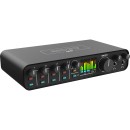
MOTU M6 |
VS | |||||||
|---|---|---|---|---|---|---|---|---|
| Analog: 6 Inputs / 4 Outputs |
Channels of I/O |
Analog: 8 Inputs / 12 Outputs Digital: 10 Inputs / 10 Outputs |
Analog: 8 Input / 6 Output at 192 kHz Digital: 10 Input / 2 Output |
Analog: 4 Inputs / 8 Outputs at 96 kHz ADAT: 16 Inputs / 16 Outputs at 48 kHz S/PDIF: 2 Inputs / 2 Outputs |
Analog: 8 Inputs / 6 Outputs Digital: 10 Inputs / 2 Outputs |
10 Input / 14 Output | 24 Inputs / 24 Outputs |
Analog: 4 Inputs / 4 Outputs |
| 192 kHz / 24-Bit | Maximum Sampling Rate | 192 kHz / 24-Bit | 192 kHz / 24-Bit | 96 kHz / 24-Bit | 192 kHz / 24-Bit | 96 kHz / 32-Bit | 96 kHz / 24-Bit | 192 kHz / 24-Bit |
| 4 Preamps | Number of Microphone Inputs | 2 Preamps | 4 Preamps | 4 Preamps | 4 Preamps | 2 Preamps | 8 Preamps | 2 Preamps |
| 4x Combo XLR-1/4" TRS Balanced/Unbalanced Mic/Line/Hi-Z Input 2x 1/4" TRS Balanced Line Input 2x 1/4" TRS Unbalanced Headphone Output 4x 1/4" TRS Balanced Line Output (DC-Coupled) |
Analog Audio I/O |
2x Combo XLR-1/4" TRS Balanced/Unbalanced Mic/Line/Hi-Z Input (Front Panel) 6x 1/4" TRS Balanced Line Input 10x 1/4" TRS Balanced Line Output (DC-Coupled) 1x 1/4" TRS Unbalanced Headphone Output (Front Panel) |
2x Combo XLR-1/4" TRS Balanced/Unbalanced Mic/Line/Hi-Z Input (Front Panel) 2x Combo XLR-1/4" TRS Balanced Mic/Line Input (Front Panel) 4x 1/4" TRS Balanced Line Input 4x 1/4" TRS Balanced Line Output 2x 1/4" TRS Unbalanced Headphone Output (Front Panel) |
4x Combo XLR-1/4" TRS Balanced Mic/Line Input 2x 1/4" TS Unbalanced Hi-Z Input 4x 1/4" TRS Balanced Line Output 2x 1/4" TRS Unbalanced Headphone Output 1x 1/8" / 3.5 mm TRS Unbalanced Headphone Output 2x 1/4" TRS Balanced Insert Send 2x 1/4" TRS Balanced Insert Return |
2x Combo XLR-1/4" TRS Balanced/Unbalanced Mic/Line/Hi-Z Input (Front Panel) 2x Combo XLR-1/4" TRS Balanced/Unbalanced Mic/Line Input (Front Panel) 4x 1/4" TRS Balanced Line Input 4x 1/4" TRS Balanced Line Output 2x 1/4" TRS Unbalanced Headphone Output (Front Panel) |
2x Combo XLR-1/4" 3-Pin Mic/Line Input 1x 1/4" TS Unbalanced Hi-Z Input (Front Panel) 2x 1/4" TRS Balanced Insert Send 2x 1/4" TRS Balanced Insert Return 4x 1/4" TRS Balanced Monitor Output 1x 1/4" TRS Headphone Output (Front Panel) 1x 1/8" / 3.5 mm TRS Headphone Output (Front Panel) |
2x Combo XLR-1/4" TRS Balanced/Unbalanced Mic/Line/Hi-Z Input (Front Panel) 6x Combo XLR-1/4" TRS Balanced Mic/Line Input 8x 1/4" TRS Balanced Line Output 2x 1/4" TRS Unbalanced Headphone Output |
2x Combo XLR-1/4" TRS Balanced/Unbalanced Mic/Line/Hi-Z Input 2x 1/4" TRS Balanced Line Input 1x 1/4" TRS Unbalanced Headphone Output 4x 1/4" TRS Balanced Line Output (DC-Coupled) 4x RCA TS Unbalanced Line Output |
| 1x USB-C | Host Connection | 1x USB-C (Class-Compliant) | 1x USB-C | 1x USB-C | 1x USB-C | 1x USB-C | 1x USB-C | 1x USB-C |
| macOS 10.11 or Later (64-Bit Only) macOS 10.13 or Later (64-Bit Only) Windows 10 or Later (64-Bit Only) |
OS Compatibility |
macOS 10.11 or Later Windows 10 13.5 or Later |
macOS 10.12 or Later Windows 7 or Later iPadOS |
macOS 10.11.6 or Later Windows 8 or Later (32-/64-Bit) |
macOS 10.11 or Later macOS 11 Windows 7 or Later |
Windows macOS |
macOS Windows |
macOS 10.11 or Later Windows 7 or Later 9 or Later |
| AC/DC Power Adapter (Included) | Power Requirements | AC/DC Power Adapter (Included) | AC/DC Power Adapter (Included) | AC/DC Power Adapter (Included) | AC/DC Power Adapter (Included) | USB Bus Power | AC Input | USB Bus Power |
